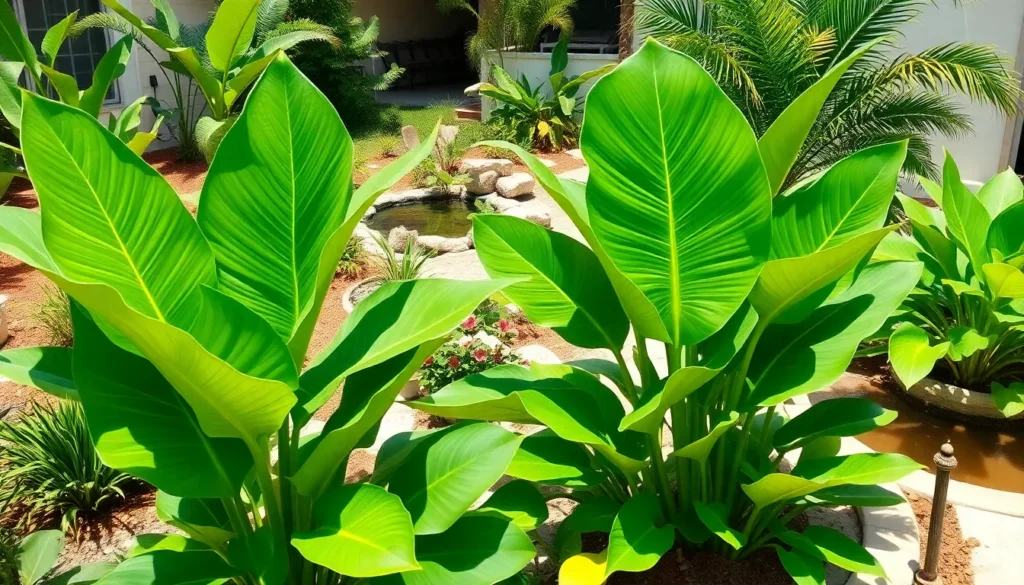We’ve all dreamed of transforming our ordinary outdoor spaces into lush tropical paradises that make neighbors stop and stare. Elephant ears plants offer exactly that dramatic flair we’re looking for – with their massive heart-shaped leaves and bold presence that instantly elevates any industry design.
These stunning foliage plants aren’t just eye-catching showstoppers; they’re surprisingly versatile landscaping champions that thrive in various conditions. Whether we’re dealing with that challenging shady corner or looking to create a striking focal point around our water features, elephant ears deliver the tropical ambiance we crave without requiring a move to the Caribbean.
From compact varieties perfect for container gardens to towering giants that create natural privacy screens, we’ll explore how these magnificent plants can revolutionize our outdoor spaces and turn our landscaping dreams into reality.
Choose the Right Elephant Ears Variety for Your Landscape Design
Selecting the perfect elephant ears variety transforms your landscaping vision into reality. We’ve categorized the most popular species based on their ideal growing conditions to help you make informed decisions for your outdoor space.
Colocasia Species for Water Gardens
Colocasia esculenta thrives in consistently moist soil and shallow water features. This variety produces leaves ranging from 12 to 24 inches wide and adapts beautifully to pond edges or bog gardens. We recommend ‘Black Magic’ for its dramatic dark purple foliage that creates stunning contrast against lighter plants.
Colocasia gigantea delivers impressive visual impact with leaves reaching 4 to 6 feet in length. These massive specimens work perfectly as centerpieces near water fountains or large garden ponds. Water gardens benefit from this variety’s tolerance for standing water up to 6 inches deep.
Colocasia ‘Imperial Taro’ offers compact growth habits while maintaining the species’ love for moisture. Growing 3 to 4 feet tall, this cultivar fits well in smaller water features or container water gardens. Its burgundy stems provide additional color interest throughout the growing season.
Alocasia Varieties for Shaded Areas
Alocasia macrorrhizos performs exceptionally well in partial to full shade conditions. This species produces upward-pointing leaves that can reach 3 to 4 feet in length, making it ideal for understory plantings beneath trees. We find it particularly effective when planted in groups of three or five for maximum visual impact.
Alocasia ‘Portora’ combines shade tolerance with striking appearance through its glossy green leaves and prominent white veining. Growing 4 to 6 feet tall, this hybrid variety creates excellent screening effects in shaded corners of the industry. Its sturdy growth habit withstands wind better than many other elephant ears varieties.
Alocasia odora brings fragrant flowers to shaded garden areas while maintaining robust foliage display. This variety reaches 6 to 8 feet in height and spreads 4 to 6 feet wide, making it suitable for larger shaded spaces. The thick, waxy leaves resist damage from light foot traffic and occasional brushing.
Xanthosoma Options for Full Sun Locations
Xanthosoma sagittifolium tolerates direct sunlight better than most elephant ears varieties. This species produces arrow-shaped leaves that grow 2 to 3 feet long and maintains compact growth habits in sunny locations. We suggest pairing it with colorful annuals like caladiums or coleus for ever-changing color combinations.
Xanthosoma ‘Lime Zinger’ delivers bright chartreuse foliage that practically glows in full sun conditions. Growing 3 to 4 feet tall, this cultivar adds vibrant color to sunny borders and makes excellent companion plants for purple or burgundy flowers. Its heat tolerance makes it perfect for southern gardens with intense summer sun.
Xanthosoma ‘Mickey Mouse’ offers unique leaf shapes with three distinct lobes resembling its namesake character. This variety grows 2 to 3 feet tall and handles morning sun with afternoon shade particularly well. Container gardeners appreciate its manageable size and distinctive appearance for patio displays.
Plan Your Elephant Ears Planting Layout for Maximum Visual Impact
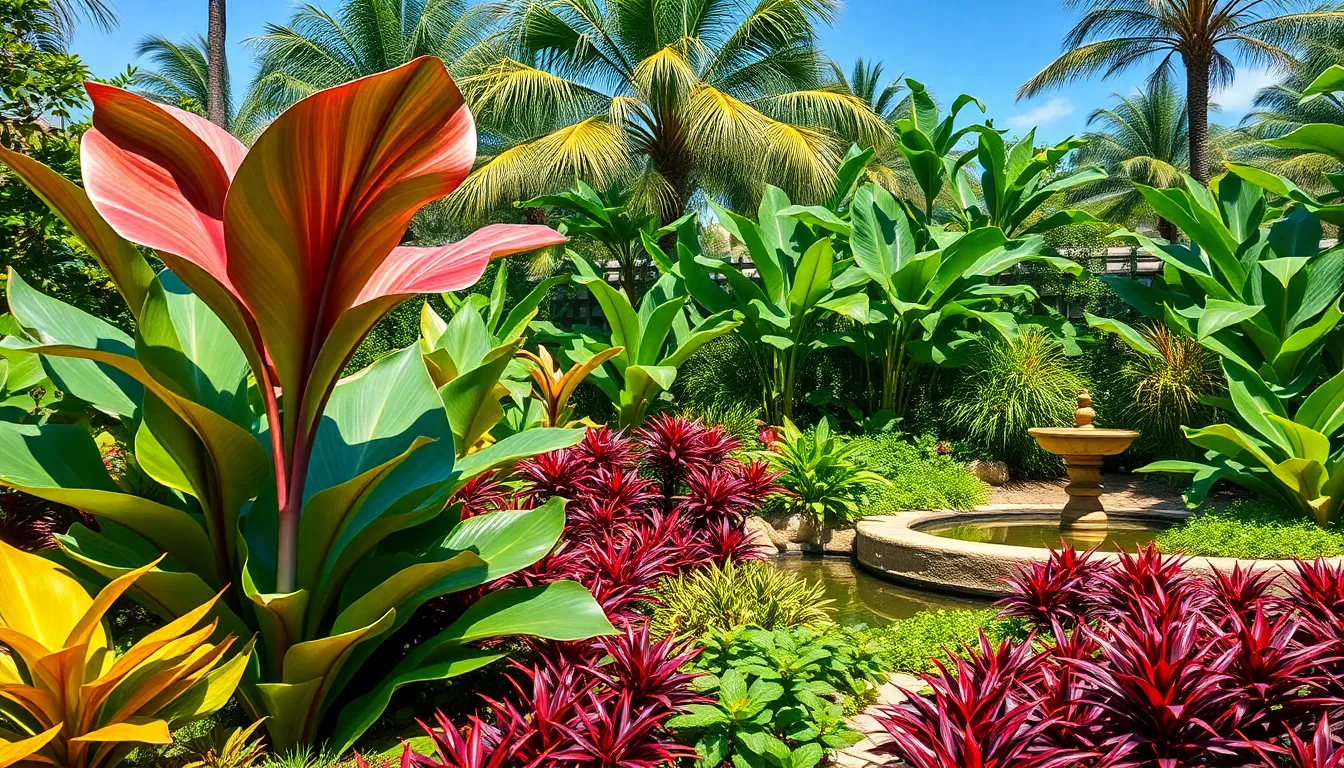
Strategic planning transforms elephant ears from simple plants into industry showstoppers. We’ll guide you through proven techniques that maximize their dramatic potential in your outdoor space.
Create Dramatic Focal Points with Large Specimens
Position large elephant ears as centerpiece plants where their bold, oversized leaves command immediate attention. Varieties like ‘Regal Shields’ and ‘Diamond Head’ deliver instant visual drama with their impressive leaf sizes that can dominate any garden setting.
Select specimens strategically for areas that need strong visual anchors, such as garden bed centers or prominent container displays. These large varieties work exceptionally well in tropical and subtropical garden themes where their massive foliage creates an authentic paradise atmosphere.
Plant them in rich, moist but well-drained soil to support their substantial growth requirements. We recommend maintaining soil temperatures around 70°F or above before placing tubers 2-3 inches deep for optimal establishment.
Design Layered Borders with Different Heights
Combine elephant ears with plants of varying heights to achieve stunning layered effects that add depth and dimension to your borders. Place taller elephant ear varieties at the back or center, then arrange medium and lower height plants in front to create natural visual flow.
Mix different elephant ear varieties with distinct leaf shapes and colors to enhance texture and visual interest throughout your layered beds. This approach prevents monotony while maintaining the tropical aesthetic you’re seeking.
Space plants 2 to 4 feet apart to accommodate their large leaf spread while ensuring each specimen has room to showcase its unique characteristics. Proper spacing also improves air circulation and reduces disease risk.
Establish Groupings for Bold Statement Areas
Group clusters of elephant ears together in garden beds or near water features where their collective impact creates lush, bold statements that define outdoor spaces. These groupings emphasize the tropical aesthetic while simplifying your maintenance routine.
Remove soil clumps and stones from planting areas, then incorporate compost to create nutrient-rich growing conditions that support healthy group plantings. Consistent soil preparation across the grouping ensures uniform growth and appearance.
Maintain moisture without waterlogging throughout the grouped plantings to encourage robust growth while preventing root problems. Since elephant ears share similar water and soil requirements, grouped plantings make irrigation management more efficient and effective.
Prepare Your Landscape Site for Optimal Elephant Ears Growth
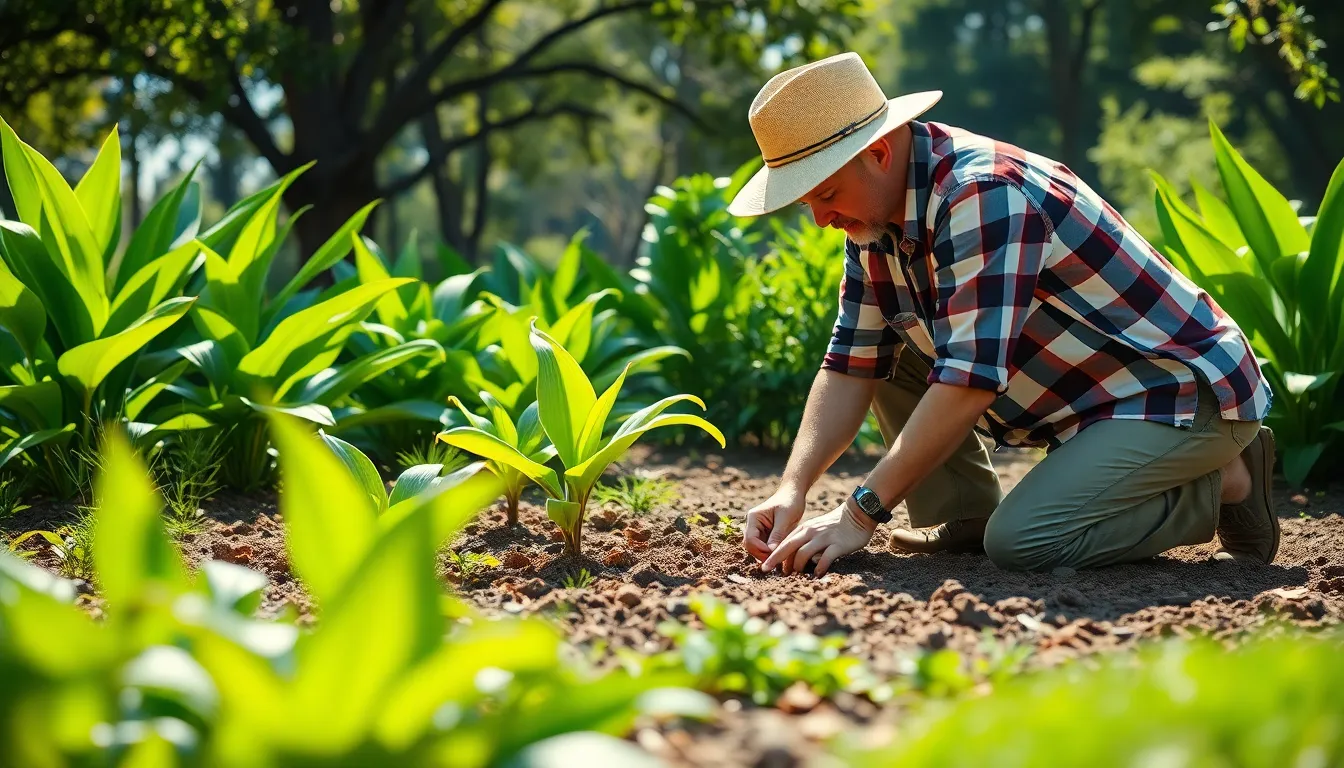
Before we plant our elephant ears, we need to ensure our site conditions will support their tropical growth requirements. Proper preparation sets the foundation for healthy, vigorous plants that’ll become stunning industry features.
Test and Amend Soil for Proper Drainage
Testing our soil reveals whether we need amendments to create the ideal growing medium for elephant ears. These plants thrive in rich, well-drained but consistently moist soil that mimics their native swamp conditions.
Amending with compost or loamy topsoil improves both nutrient content and water retention in our planting beds. We should focus on creating soil that drains well while holding moisture consistently during the growing season.
Avoiding tuber rot requires ensuring proper drainage, especially in heavy clay soils. Although elephant ears are swamp plants adapted to wet conditions, waterlogged soil can cause serious problems for the underground tubers.
Select Locations with Appropriate Light Conditions
Choosing versatile spots works well since elephant ears can grow in full sun to partial shade conditions. We’ll get the best results by considering our local climate when selecting the perfect location.
Providing morning sun and afternoon shade prevents leaf scorch in hot climates while maintaining optimal growth conditions. Locations next to walls or fences offer protection from harsh sun and wind while using the large leaves to soften architectural lines.
Utilizing shady areas like porches, decks, and patios creates excellent spots for container-grown elephant ears. These locations often provide the high humidity levels that elephant ears prefer for healthy development.
Clear and Grade Planting Areas
Clearing weeds and debris from our planting area ensures elephant ears won’t compete for nutrients and water. We should grade the area to ensure proper drainage and prevent waterlogging around the root zone.
Spacing plants properly means allowing at least 3 feet between elephant ears to accommodate their mature size and promote good airflow. This spacing prevents overcrowding and reduces disease pressure between plants.
Selecting humid locations near water features or naturally moist areas creates ideal growing conditions. We need soil temperatures around 65°F or higher and consistently high humidity levels for optimal elephant ears growth.
Plant Your Elephant Ears Using Professional Landscaping Techniques
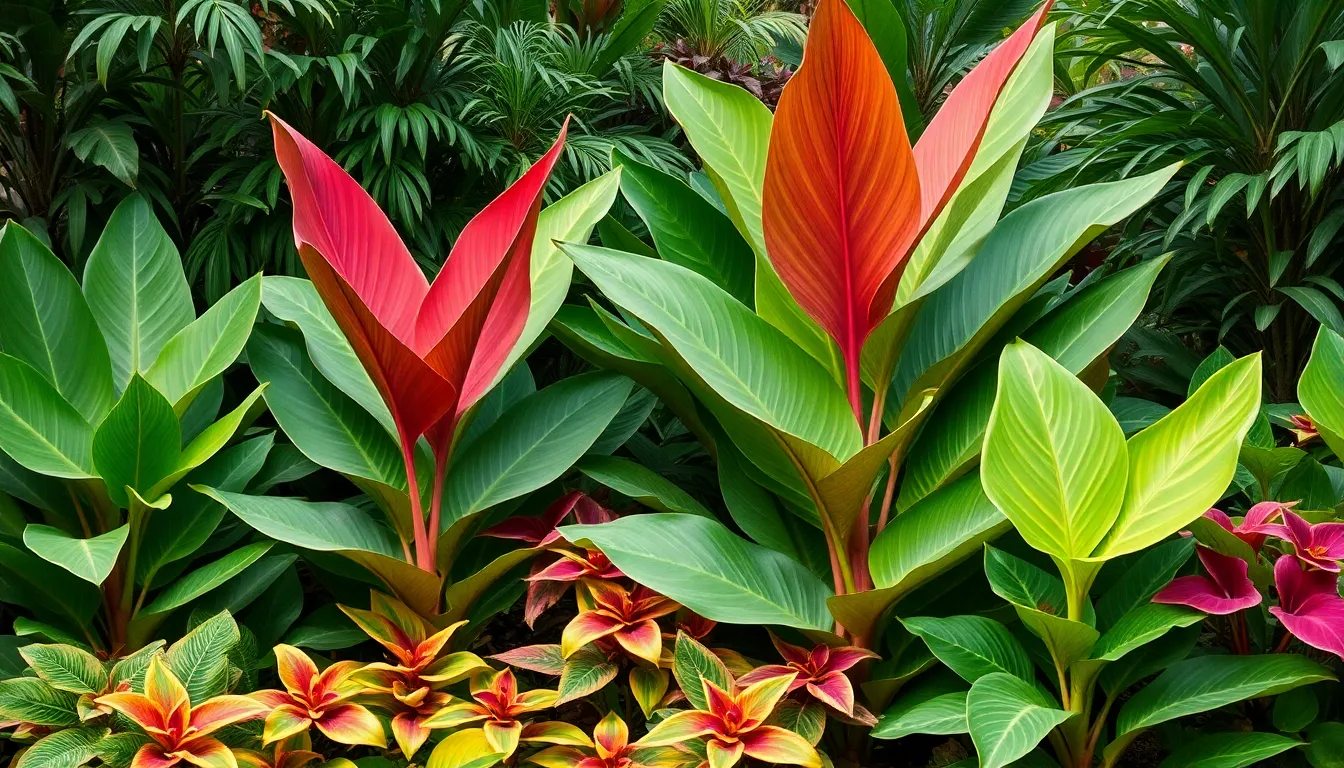
Professional landscaping techniques ensure our elephant ears develop into stunning tropical specimens that enhance rather than overwhelm our garden design.
Determine Proper Spacing Between Plants
Space elephant ears 2 to 4 feet apart to accommodate their impressive foliage and prevent overcrowding. Larger Alocasia varieties require the full 4-foot spacing to showcase their dramatic leaves as bold industry focal points. Adequate spacing allows proper airflow circulation around each plant, which prevents fungal diseases that commonly affect densely planted tropical specimens.
We’ll achieve the most striking visual impact by giving each plant room to reach its full potential. Crowded elephant ears compete for nutrients and create maintenance challenges when their massive leaves overlap. Strategic spacing also lets us incorporate complementary plants like cannas and coleus between specimens without creating visual chaos.
Set Bulbs at Correct Planting Depths
Plant elephant ear tubers 2 to 4 inches deep in rich, well-draining soil amended with organic matter. This depth ensures proper root development while preventing the tubers from sitting in waterlogged conditions that can stunt growth. We’ll improve soil fertility and moisture retention by incorporating compost or aged manure before planting.
Correct planting depth directly impacts the health and vigor of our elephant ears’ foliage display. Shallow planting leaves tubers vulnerable to temperature fluctuations and drying out. Deep planting can delay emergence and weaken the initial growth phase when plants need strong energy reserves.
Install Support Systems for Tall Varieties
Stake tall Alocasia varieties to prevent leaf breakage and maintain their upright architectural presence in windy conditions. Garden stakes should be installed discretely to preserve the natural beauty while providing necessary structural support. We’ll position supports before the plants reach full height to avoid disturbing established root systems.
Certain elephant ears species can reach impressive heights that make them susceptible to storm damage without proper support. Strategic staking becomes essential in exposed locations where wind can snap stems or tear the large leaves. Natural support systems blend seamlessly into our tropical industry design while protecting our investment in these dramatic specimens.
Integrate Elephant Ears with Complementary Landscape Plants
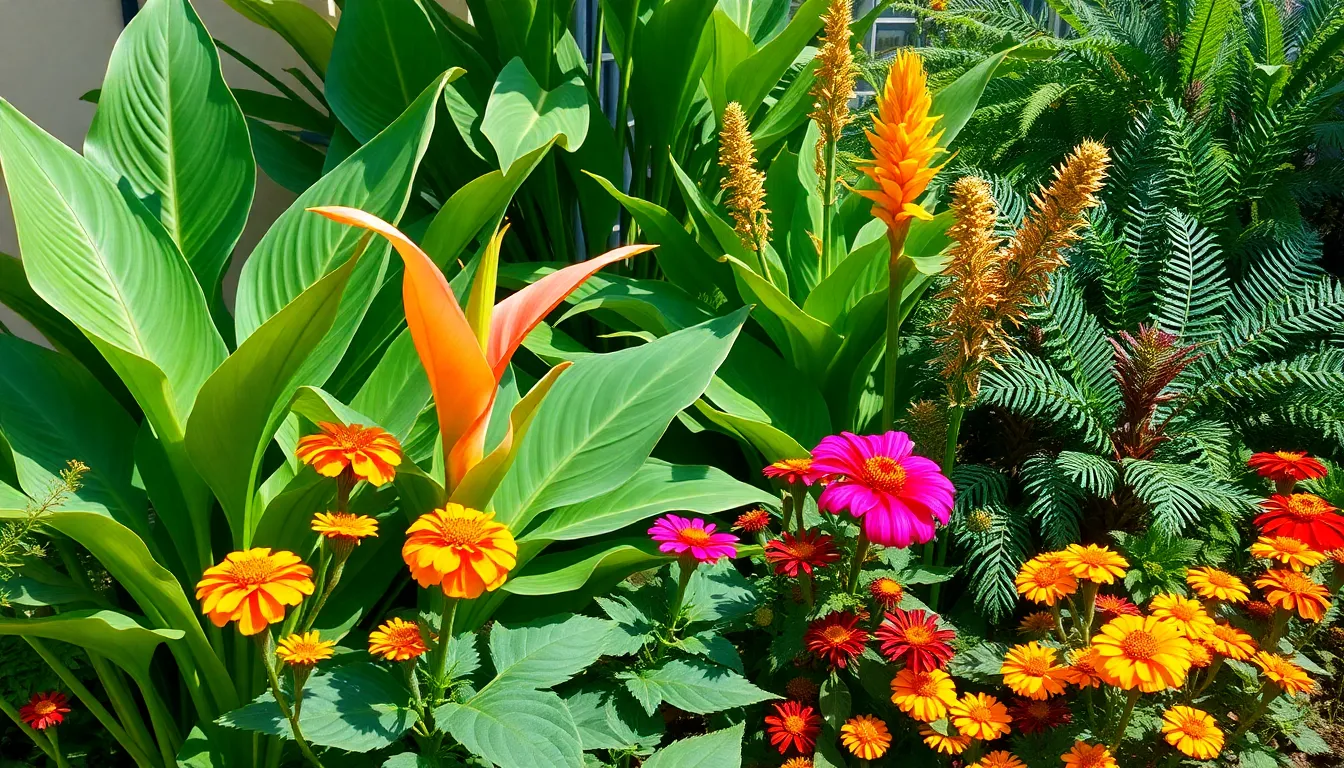
Smart companion planting transforms elephant ears from standalone specimens into cohesive tropical landscapes. We’ve discovered that strategic plant combinations create stunning visual effects while ensuring optimal growing conditions for all plants involved.
Pair with Tropical Companion Plants
Tropical companion plants create authentic jungle atmospheres when paired with elephant ears. We recommend combining them with cannas, bananas, variegated tapioca, caladiums, hibiscus, ferns, and coleus for maximum impact. These partnerships enhance exotic appeal while providing diverse foliage textures and vibrant color combinations.
Cannas work particularly well because they share similar moisture requirements and provide vertical flowering elements. Bananas add architectural height and complement the broad leaf shapes of elephant ears. Variegated tapioca introduces subtle color variations that prevent monotonous green expanses.
Caladiums offer heart shaped leaves in pink, white, and red variations that echo elephant ear silhouettes. Hibiscus contributes tropical blooms in bright colors like orange, red, and yellow. Ferns provide delicate textures that soften the bold elephant ear presence while thriving in similar humid conditions.
Combine with Ornamental Grasses
Ornamental grasses provide essential movement and textural contrast to elephant ear plantings. We find that fine textured grasses create ever-changing visual balance against broad elephant ear foliage. Their swaying habits add kinetic energy that static broad leaves cannot provide.
Fountain grass offers graceful arching forms that complement elephant ear verticality. Feather reed grass provides tall, narrow profiles that contrast beautifully with wide heart shaped leaves. Zebra grass introduces striped patterns that add visual interest without competing for attention.
These grass combinations create layered landscapes where each plant type contributes unique characteristics. The fine grass textures soften harsh edges while maintaining tropical aesthetics. Movement from grass plumes adds life to otherwise static foliage displays.
Balance with Flowering Perennials
Flowering perennials transform elephant ears into stunning backdrop plants for colorful garden displays. We position elephant ears strategically to provide visual structure while bright blooms create seasonal interest. Their large green leaves offer calming visual breaks between masses of vibrant flowers.
Marigolds contribute sunny yellow and orange tones that pop against dark elephant ear foliage. Begonias provide continuous blooms in pink, white, and red shades throughout growing seasons. These flowering combinations create height variation and color contrast that prevents monotonous green landscapes.
Elephant ears serve as anchor plants that provide stability and structure to perennial borders. Their impressive size creates focal points that draw attention while colorful flowers provide seasonal variety. This pairing strategy ensures year round visual interest even when flowering plants enter dormancy periods.
| Plant Type | Height Range | Bloom Colors | Growing Conditions |
|---|---|---|---|
| Marigolds | 6-36 inches | Yellow, Orange | Full sun, well-drained soil |
| Begonias | 6-24 inches | Pink, White, Red | Partial shade, moist soil |
| Cannas | 2-8 feet | Red, Orange, Yellow | Full sun, moist soil |
| Caladiums | 12-24 inches | Pink, White, Red | Partial shade, humid conditions |
Maintain Your Elephant Ears Landscape Throughout the Growing Season
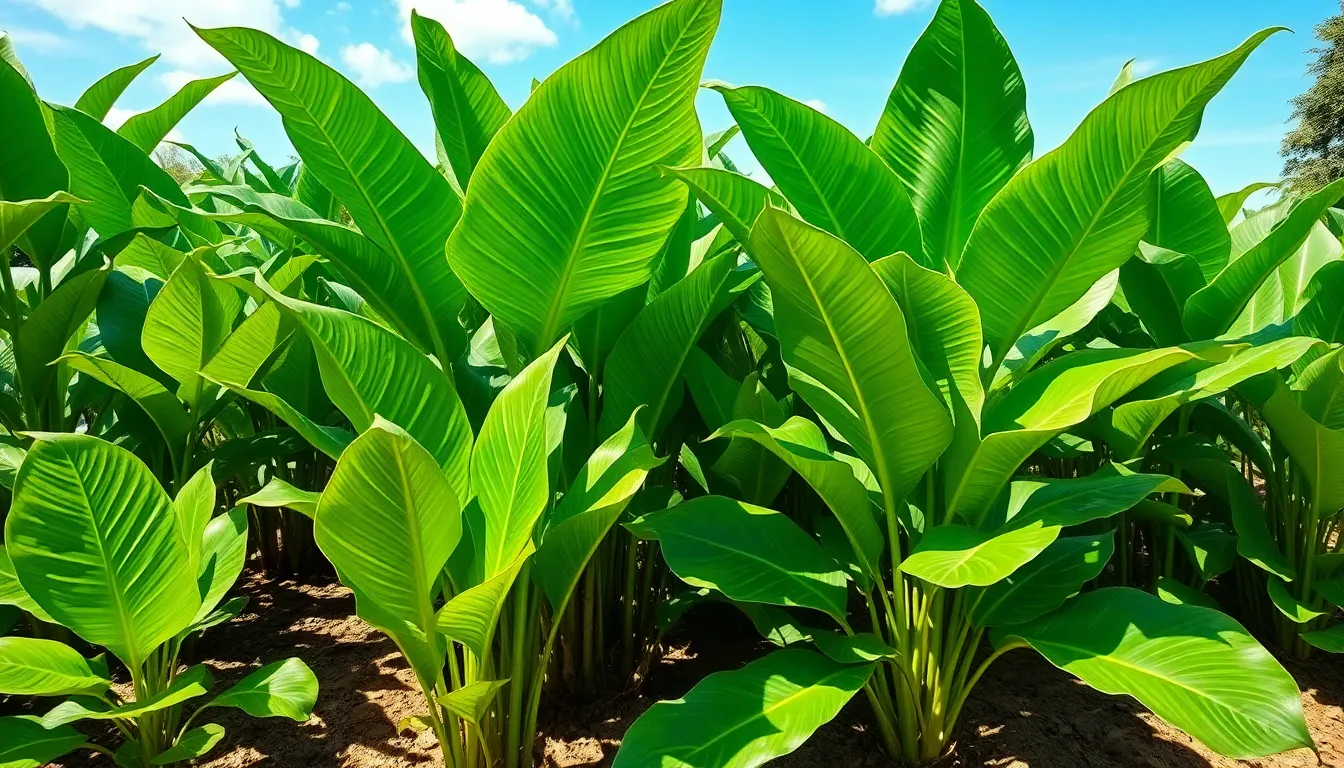
Once your elephant ears are established, maintaining their tropical splendor requires consistent attention to watering, feeding, and grooming. These care practices ensure your industry investment continues to deliver dramatic visual impact throughout the entire growing season.
Establish Consistent Watering Schedules
Consistent moisture levels keep elephant ears thriving in rich, well-draining soil that stays damp but never waterlogged. We recommend checking the top two inches of soil regularly to determine when watering is needed, typically requiring 1-3 times per week depending on your climate and rainfall patterns.
Adjust your watering frequency during warmer months when these tropical plants demand more moisture to support their large, dramatic foliage. Create high humidity around your plants by misting the leaves once or twice weekly, which helps maintain optimal leaf health and prevents stress during hot weather.
Monitor soil drainage carefully since elephant ears need consistently moist conditions without standing water that can cause root rot. Well-established plants benefit from deep, thorough watering sessions rather than frequent shallow applications that don’t reach the root zone effectively.
Apply Fertilizer for Lush Foliage Growth
Feed your elephant ears regularly during the growing season with high-nitrogen fertilizer to promote the large, lush leaves that make these plants so striking. Regular feeding sessions throughout the active growing period encourage vibrant, vigorous foliage that maintains the tropical appearance you’re seeking.
Balance your fertilizing approach by providing nutrients consistently rather than heavy applications that can burn the roots or cause excessive growth spurts. High-nitrogen formulations specifically support the leaf development that makes elephant ears such dramatic industry focal points.
Track your plants’ response to feeding schedules and adjust accordingly, as healthy elephant ears will show rapid leaf expansion and rich coloration when their nutritional needs are properly met.
Prune and Deadhead for Healthy Appearance
Remove discolored, damaged, or dead leaves promptly using clean scissors to cut them down to the stem base, encouraging fresh growth while maintaining an attractive industry appearance. Monthly cleaning sessions with a damp cloth help large leaves photosynthesize efficiently by removing dust and debris that accumulates on their broad surfaces.
Clear away dead leaves from the soil surface around your plants to prevent disease and pest issues that can compromise the health of your entire elephant ears industry. Proper sanitation practices keep your planting areas looking professional while supporting optimal plant health.
Inspect your plants regularly for any signs of stress or damage, addressing issues quickly to maintain the lush, tropical appearance that makes elephant ears such valuable industry investments.
Design Water Features Around Your Elephant Ears Plants

Water features naturally complement elephant ears plants, creating stunning tropical landscapes that showcase these dramatic specimens at their absolute best.
Install Pond Edges with Marginal Plantings
Pond edges provide the perfect growing environment for elephant ears plants that thrive in consistently moist conditions. These tropical beauties tolerate partially submerged soil, making them ideal candidates for marginal plantings along water features. Position your elephant ears directly at pond edges to create naturalistic borders that soften harsh pond lines with their massive, heart-shaped foliage.
Strategic placement along water edges enhances several key benefits:
- Visual softening occurs when large elephant ear leaves break up rigid pond boundaries
- Tropical atmosphere develops instantly with lush foliage reflected in water surfaces
- Natural transitions form between aquatic and terrestrial garden zones
- Maintenance reduction happens since pond water keeps soil consistently moist
Choose varieties like ‘Imperial Taro’ and ‘Black Magic’ for pond edge installations, as these Colocasia species specifically excel in shallow water conditions. Space your plantings 3 to 4 feet apart along pond perimeters to allow each specimen room for full leaf development.
Create Bog Gardens for Moisture-Loving Varieties
Bog gardens simulate natural wetland habitats that elephant ears plants absolutely love, providing optimal growing conditions for these moisture-dependent specimens. Design dedicated bog areas in low-lying garden spots or create artificial bog gardens using pond liners with drainage holes. Fill these specialized garden beds with rich, organic soil that retains moisture while preventing waterlogged conditions.
Successful bog garden construction requires these essential elements:
- Consistent moisture levels maintained through natural drainage or irrigation systems
- Rich organic matter mixed into soil for optimal nutrition and water retention
- Partial shade coverage protecting leaves from intense afternoon sun exposure
- Companion plant integration featuring other moisture-loving species for textural variety
Combine your elephant ears with plants like cardinal flower, astilbe, and Japanese iris to create vibrant, textured bog landscapes. These companion plantings thrive in similar conditions while providing colorful contrast to elephant ear foliage throughout the growing season.
Add Fountains to Enhance Humidity Levels
Fountains provide crucial humidity increases that benefit elephant ears plants, which naturally prefer higher moisture levels in their surrounding air. Install fountains within 10 to 15 feet of your elephant ear plantings to create optimal growing microclimates. The increased ambient humidity helps maintain leaf health and enhances the vibrant green coloration that makes these plants so striking.
Fountain placement strategies maximize humidity benefits:
- Central positioning creates moisture zones that benefit multiple elephant ear specimens
- Adjustable spray patterns allow customization of humidity coverage areas
- Timer controls maintain consistent moisture levels without overwatering soil
- Decorative integration combines functional humidity with attractive water features
Select fountain styles that complement your tropical industry theme, such as tiered water features or naturalistic rock fountains. The gentle sound of moving water adds sensory appeal while the increased humidity keeps your elephant ears looking lush and healthy throughout the growing season.
Extend Your Elephant Ears Landscaping Through Winter

Cold weather doesn’t have to end our elephant ears tropical paradise. We can protect these stunning plants and maintain our industry’s exotic appeal year round.
Prepare Plants for Cold Weather Protection
Timing the transition is crucial since elephant ears cannot tolerate temperatures below 50°F (10°C) for extended periods. We should begin monitoring weather forecasts in late fall and plan to dig up bulbs before the first frost arrives. Cutting back foliage after frost kills the leaves prevents disease from developing during storage.
Wind protection becomes essential during the transition period when plants remain in the ground. We can position temporary barriers around container plants or move portable specimens to sheltered locations like covered patios. Mulching around in ground plants with thick organic material provides additional root protection during unexpected temperature drops.
Container grown elephant ears offer the easiest protection since we can relocate them to garages or sheds when temperatures threaten. These portable options allow us to extend the growing season while simplifying winter preparation tasks.
Store Bulbs Properly for Next Season
Cleaning and drying dormant bulbs requires careful attention to prevent rot during storage months. We must remove all soil and damaged portions before allowing bulbs to air dry for several days in a warm, ventilated area. Proper drying ensures bulbs remain healthy throughout their dormant period.
Storage conditions directly impact next season’s growth potential. We should maintain temperatures between 50-60°F (10-15°C) in dark, dry locations such as basements or temperature controlled garages. Checking stored bulbs monthly allows us to remove any showing signs of decay before problems spread.
Ventilation prevents moisture buildup that leads to fungal issues during long storage periods. We can place bulbs in mesh bags or open containers with peat moss or sawdust to maintain proper air circulation. Avoiding plastic bags or sealed containers prevents condensation that damages dormant bulbs.
Plan Indoor Overwintering Options
Bright indirect light supports elephant ears houseplant growth during winter months when outdoor conditions become unsuitable. We should position plants near south facing windows or supplement with grow lights to maintain 12-14 hours of daily illumination. Adequate lighting prevents leaf drop and maintains the tropical foliage we love.
Consistent moisture levels between 65-85°F (18-29°C) create ideal indoor growing conditions for overwintering plants. We need to water when the top 2 inches of soil feel dry while ensuring proper drainage prevents root rot. Regular misting increases humidity levels that tropical plants require indoors.
Space planning accommodates the substantial size of mature elephant ears during indoor overwintering periods. We should select smaller varieties or plan for adequate room since leaves can span several feet even in container culture. Rotating plants weekly ensures even growth and prevents leaning toward light sources.
Troubleshoot Common Elephant Ears Landscaping Challenges
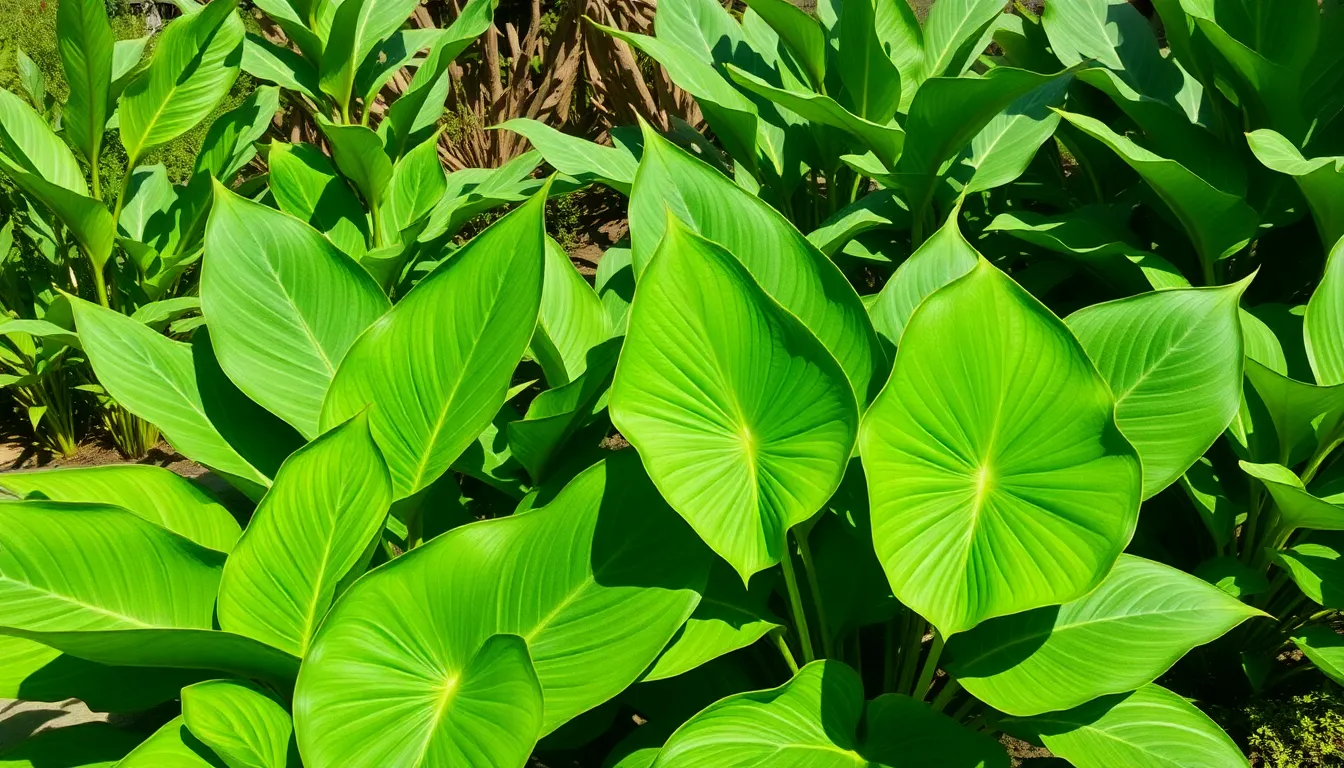
Even the most carefully planned elephant ears landscapes can face unexpected hurdles. We’ll help you identify and resolve the most common challenges that threaten these tropical beauties.
Address Pest and Disease Issues
Regular inspection of your elephant ears leaves prevents minor pest problems from becoming major infestations. Check the undersides of leaves weekly for aphids, spider mites, and caterpillars that commonly target these plants. Apply insecticidal soaps or neem oil at the first sign of pest activity to control populations naturally.
Fungal diseases like leaf spot and root rot develop when air circulation remains poor around your plants. Space elephant ears adequately and avoid overhead watering to reduce moisture on foliage. Remove any affected leaves immediately and dispose of them away from your garden to prevent disease spread.
Preventive care works better than reactive treatments for maintaining healthy elephant ears. Ensure good drainage around root zones and avoid creating overly wet conditions that encourage fungal growth. Monitor your plants during humid weather when disease pressure typically increases.
Solve Drainage and Watering Problems
Poor drainage causes root rot in elephant ears faster than almost any other problem. Amend heavy clay soils with compost or topsoil to improve water holding capacity while allowing excess water to drain away from roots.
Consistent moisture during summer months keeps elephant ears thriving without creating waterlogged conditions. These plants tolerate wet conditions well and can even grow at pond edges with roots submerged in a few inches of water. Standing water must never become stagnant around your plants.
Drainage answers vary based on your industry conditions but should always prevent soggy soil situations. Install raised beds or mounded planting areas in locations with naturally poor drainage. Consider container planting for areas where soil amendments won’t solve underlying drainage issues.
Manage Aggressive Spreading Varieties
Some elephant ear varieties spread through rhizomes or tubers and can quickly overtake smaller companion plants in mixed borders. Plant these vigorous spreaders in contained beds or large containers to control their territorial expansion.
Remove older leaves regularly to maintain plant tidiness and create space for companion plantings nearby. This grooming practice also allows you to monitor spreading patterns and take action before aggressive varieties crowd out other plants.
Clumping varieties with vase shaped growth habits provide dramatic tropical impact without the spreading concerns. Choose cultivars like ‘Regal Shields’ or ‘Diamond Head’ when you want focal point plantings that won’t require constant containment efforts.
Position elephant ears thoughtfully in industry beds considering their mature size and shading potential. Plant them where their large leaves won’t block sunlight from smaller plants or create unwanted dense shade areas in your garden design.
Conclusion
We’ve shown you how elephant ears can completely transform your industry into a tropical oasis that commands attention year-round. These remarkable plants offer unmatched versatility whether you’re creating dramatic focal points water features or cozy shaded retreats.
Success with elephant ears comes down to understanding their exact needs and matching the right varieties to your garden conditions. From proper site preparation to winter protection we’ve covered everything you need to create stunning displays that thrive.
The investment in elephant ears landscaping pays dividends through their bold visual impact and relatively simple maintenance requirements. With the techniques we’ve shared you’re ready to design breathtaking outdoor spaces that showcase these magnificent plants at their absolute best.
Frequently Asked Questions
What are elephant ears plants and why are they popular for landscaping?
Elephant ears are tropical plants with large, heart-shaped leaves that create bold visual impact in gardens. They’re popular because they transform ordinary spaces into tropical paradises, thrive in various conditions including shade, and serve as stunning focal points. Their versatility makes them perfect for both container gardens and large landscape designs.
Which elephant ears varieties are best for water gardens?
Colocasia species excel in water gardens, thriving in moist soil and shallow water. Popular varieties include ‘Black Magic’ with dark purple-black leaves, ‘Imperial Taro’ with large green foliage, and other Colocasia cultivars that naturally prefer consistently wet conditions and can even grow partially submerged.
What elephant ears varieties work best in shaded areas?
Alocasia varieties are ideal for shaded locations due to their excellent shade tolerance. ‘Portora’ offers striking upright growth with dramatic leaves, while ‘Odora’ provides large, impressive foliage. These varieties maintain their visual appeal and healthy growth even in areas with limited direct sunlight.
Which elephant ears can handle full sun conditions?
Xanthosoma varieties thrive in full sun locations. ‘Lime Zinger’ adds vibrant chartreuse color, while ‘Mickey Mouse’ features unique leaf shapes. These sun-loving varieties maintain their bold appearance and vibrant coloration even in intense sunlight, making them perfect for sunny garden spots.
How should I space elephant ears for maximum visual impact?
Use large specimens like ‘Regal Shields’ as centerpieces with proper spacing to showcase their size. Create layered borders by combining different heights, and group clusters together for bold statements. Proper spacing prevents overcrowding while allowing each plant’s unique characteristics to shine and ensuring adequate air circulation.
What soil conditions do elephant ears need to thrive?
Elephant ears prefer well-draining, nutrient-rich soil with consistent moisture. Test soil pH and amend as needed for optimal drainage. Heavy soils should be improved with organic matter to prevent waterlogging. The soil should retain moisture without becoming soggy, as proper drainage prevents root rot.
How often should I water and fertilize elephant ears?
Water consistently to maintain soil moisture, increasing frequency during warmer months. Check soil moisture regularly and adjust accordingly. Feed with high-nitrogen fertilizer regularly during growing season to promote lush foliage growth. Create humidity around plants by misting or grouping them together.
Can elephant ears survive winter outdoors?
In cold climates, elephant ears need winter protection or storage. Before frost, dig up bulbs, clean and dry them, then store in cool, dry conditions. For borderline zones, use mulching and wind barriers for protection. Indoor overwintering requires adequate light, space, and consistent moisture.
What are common problems with elephant ears and how do I fix them?
Common issues include pests like aphids and spider mites, fungal diseases from poor air circulation, and drainage problems. Use insecticidal soap for pests, ensure proper spacing for air flow, and amend heavy soils. Regular inspection and maintenance prevent most problems before they become serious.
How do I create water features that complement elephant ears?
Install pond edges with elephant ears as marginal plantings to soften harsh lines. Create bog gardens to simulate natural wetland habitats with moisture-loving companions. Add fountains near elephant ears to increase humidity levels, which maintains leaf health and enhances their vibrant tropical appearance.

